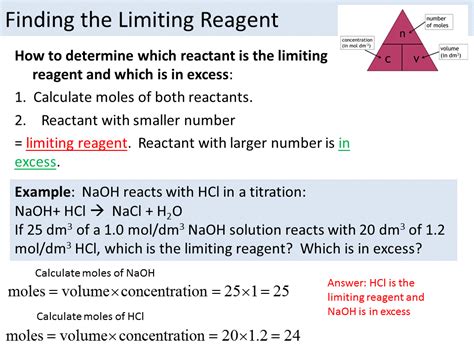How to Calculate the Limiting Reagent: A Step-by-Step Guide
Determining the limiting reagent is crucial in stoichiometry, as it dictates the maximum amount of product that can be formed in a chemical reaction. Understanding this concept is essential for anyone studying chemistry, whether you're a high school student or a seasoned researcher. This guide will walk you through the process, providing a clear and concise explanation with practical examples.
What is a Limiting Reagent?
In a chemical reaction, reactants combine in specific ratios according to the balanced chemical equation. The limiting reagent (also called the limiting reactant) is the reactant that gets completely consumed first, thus limiting the amount of product that can be formed. Once the limiting reagent is used up, the reaction stops, even if other reactants are still present.
Steps to Identify the Limiting Reagent
Here's a step-by-step approach to calculating the limiting reagent:
1. Write and Balance the Chemical Equation:
This is the foundation of any stoichiometric calculation. Ensure the equation accurately represents the reaction and that it's balanced, meaning the number of atoms of each element is the same on both sides of the equation. For example:
2H₂ + O₂ → 2H₂O
2. Convert Grams to Moles:
Chemical reactions occur at the molar level. Therefore, you need to convert the given masses of each reactant into moles using their respective molar masses. Remember, the molar mass is the mass of one mole of a substance (grams/mol), found on the periodic table for elements or calculated for compounds.
-
Example: Let's say you have 10 grams of H₂ and 50 grams of O₂.
-
Moles of H₂ = (10 g H₂) / (2.02 g/mol H₂) ≈ 4.95 moles H₂
-
Moles of O₂ = (50 g O₂) / (32.00 g/mol O₂) ≈ 1.56 moles O₂
3. Determine the Mole Ratio:
Use the balanced chemical equation to find the mole ratio between the reactants. This ratio shows the proportion in which the reactants combine. In our example:
The balanced equation (2H₂ + O₂ → 2H₂O) shows a 2:1 mole ratio of H₂ to O₂. This means that for every 2 moles of H₂ reacted, 1 mole of O₂ is needed.
4. Calculate the Required Moles:
Use the mole ratio to determine how many moles of one reactant are required to completely react with the available moles of the other reactant.
- From the perspective of H₂: If you have 4.95 moles of H₂, you would need 4.95 moles H₂ * (1 mol O₂ / 2 mol H₂) ≈ 2.48 moles of O₂.
- From the perspective of O₂: If you have 1.56 moles of O₂, you would need 1.56 moles O₂ * (2 mol H₂ / 1 mol O₂) ≈ 3.12 moles of H₂.
5. Identify the Limiting Reagent:
Compare the required moles calculated in step 4 to the available moles calculated in step 2. The reactant that requires more moles of the other reactant than are available is the limiting reagent.
- In our example: We have 1.56 moles of O₂, but reacting all the H₂ requires 2.48 moles of O₂. Therefore, O₂ is the limiting reagent. We have enough O₂ to react with only 3.12 moles of H₂ while we have 4.95 moles of H₂ available; thus H₂ is in excess.
6. Calculate the Theoretical Yield (Optional):
Once you've identified the limiting reagent, you can calculate the theoretical yield of the product. This is the maximum amount of product that can be formed based on the amount of limiting reagent.
- Example: Using the limiting reagent (O₂), we have 1.56 moles O₂. According to the balanced equation, 1 mole of O₂ produces 2 moles of H₂O.
- Therefore, the theoretical yield of H₂O is 1.56 moles O₂ * (2 mol H₂O / 1 mol O₂) ≈ 3.12 moles H₂O. You can convert this to grams if needed using the molar mass of H₂O.
Troubleshooting Common Mistakes
- Incorrectly balanced equations: Always double-check your balanced chemical equation. An unbalanced equation will lead to incorrect mole ratios and an inaccurate determination of the limiting reagent.
- Unit conversions: Be meticulous with unit conversions. Make sure all your calculations are consistently using the same units (grams, moles, etc.).
- Mole ratio interpretation: Understand the significance of the mole ratio from the balanced chemical equation. This is the key to relating the amounts of reactants.
By carefully following these steps, you can confidently determine the limiting reagent in any chemical reaction and calculate the maximum yield of the product. Remember practice makes perfect – the more problems you work through, the more comfortable you’ll become with this crucial concept.
